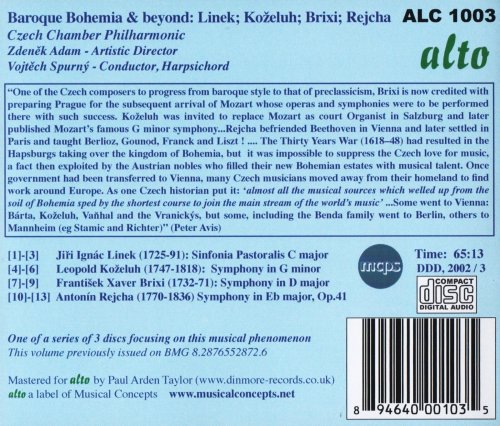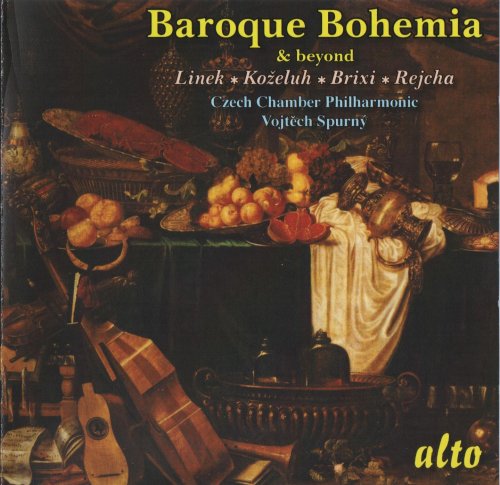
Czech Chamber Philharmonic, Vojtěch Spurný - Baroque Bohemia & Beyond, Vol. 3 (2002)
BAND/ARTIST: Czech Chamber Philharmonic, Vojtěch Spurný
- Title: Baroque Bohemia & Beyond, Vol. 3
- Year Of Release: 2002
- Label: Alto
- Genre: Classical
- Quality: FLAC (image+.cue,log,scans)
- Total Time: 65:13
- Total Size: 324 Mb
- WebSite: Album Preview
Tracklist:
Jiří Ignác Línek (1725–1791):
01. Sinfonia pastoralis in C major: Allegro [0:07:31.14]
02. Sinfonia pastoralis in C major: Adagio [0:05:49.12]
03. Sinfonia pastoralis in C major: Presto [0:02:01.27]
Leopold Koželuch (1747–1818):
04. Symphony in G minor: Allegro [0:06:55.39]
05. Symphony in G minor: Adagio [0:05:52.21]
06. Symphony in G minor: Presto [0:05:18.63]
František Xaver Brixi (1732–1771):
07. Symphony in D major: Allegro molto [0:03:18.71]
08. Symphony in D major: Andantino [0:03:24.17]
09. Symphony in D major: Allegro molto, alla breve [0:02:00.63]
Antonín Rejcha (1770-1836):
10. Symphony in E flat major, Op. 41: Largo allegro spirituoso [0:07:44.26]
11. Symphony in E flat major, Op. 41: Andante un poco adagio [0:05:57.10]
12. Symphony in E flat major, Op. 41: Allegro [0:03:57.23]
13. Symphony in E flat major, Op. 41: Un poco vivo [0:05:21.66]
Performers:
Czech Chamber Philharmonic
Vojtěch Spurný - conductor, harpsichord

Jiří Ignác Línek (1725–1791):
01. Sinfonia pastoralis in C major: Allegro [0:07:31.14]
02. Sinfonia pastoralis in C major: Adagio [0:05:49.12]
03. Sinfonia pastoralis in C major: Presto [0:02:01.27]
Leopold Koželuch (1747–1818):
04. Symphony in G minor: Allegro [0:06:55.39]
05. Symphony in G minor: Adagio [0:05:52.21]
06. Symphony in G minor: Presto [0:05:18.63]
František Xaver Brixi (1732–1771):
07. Symphony in D major: Allegro molto [0:03:18.71]
08. Symphony in D major: Andantino [0:03:24.17]
09. Symphony in D major: Allegro molto, alla breve [0:02:00.63]
Antonín Rejcha (1770-1836):
10. Symphony in E flat major, Op. 41: Largo allegro spirituoso [0:07:44.26]
11. Symphony in E flat major, Op. 41: Andante un poco adagio [0:05:57.10]
12. Symphony in E flat major, Op. 41: Allegro [0:03:57.23]
13. Symphony in E flat major, Op. 41: Un poco vivo [0:05:21.66]
Performers:
Czech Chamber Philharmonic
Vojtěch Spurný - conductor, harpsichord
Second in this series of bringing lesser known Bohemian composers to light, this recording contains 2 symphonies written squarely in the Classical Era by cosmopolitan inhabitants of Vienna and Paris. However, the other two are transitional works composed by those who never left their native land.
Born near Prague, Jiri Linek (1725-1791) composed at least 200 works, most of which were for the church. Written in C Major, his Sinfonia Pastoralis opens with a cheerful ‘Allegro’ complete with a full complement of horns and winds using driving pairs of repeated notes in the accompaniment. Alternating fortissimo passages with softer sections creates a rocking contrast while allowing one vestige of the baroque to be heard – a harpsichord continuo.
The 2nd movement ‘Adagio’ also features discreet support from the keyboard. Composed for strings only, it employs long, extended melodic phrases in the violins. A rollicking triple metered ‘Presto’ finds the full orchestra returning with the oboes supplying a plaintive echo of the lead violins.
From the opening bars of the G Minor symphony of Leopold Kozeluch (1747-1818), it is clear we are beyond Baroque. More advanced part writing and a wider range of dynamic coloration validate that premise, with the hushed urgency of the pianissimo passages particularly appealing. Over sustained pedal notes in the bassoons and lower strings, the 1st movement ‘Allegro’ sweeps along with vigorous violins leading the way.
Although violins also present the initial melody in the following ‘Adagio’, horns and oboes are prominently featured. Almost in suspended time, the 2nd movement drifts to a placid ending before a rousing ‘Presto’ erupts. Driven by urgent repeated notes first in the violins, then taken up in the lower strings, the final section thunders to a rousing unison ending.
Known primarily for his sacred music, Frantisek Brixi (1732-1771) was born in Prague becoming the city’s best known composer by the age of 27. His Symphony in D Major is the only one he wrote, and takes the listener back to the transitional period before Mozart arrived where musical sections are repeated rather than developed.
Galloping crescendos open the ‘Allegro molto’, with frantic fiddling from the violins and propelled a relentless dotted rhythm. A charming ‘Andantino’ follows, marked by cascading lines first in the upper strings, then carried in the horns and winds, all the while supported by a sturdy harpsichord. After a busy opening statement by the violins in the ‘Allegro molto’, the winds take over this brief but effective finale.
The concluding symphony is a mature, 4 movement work in E Flat composed by Anton Reicha (1770-1836). Found on numerous other recordings, the Op.41 is here a given an expansive, stately reading by the Czech Chamber Orchestra under the baton of Vojtech Spurny. After winds open the introductory ‘Largo’, rumbling tympani announce the ‘Allegro sprituoso’ which forms the bulk of the 1st movement. Advanced composition for both horns and strings, better orchestral integration and real development sections all stamp this work as a true Classical era symphony.
A triple metered ‘Andante un poco adagio’ sweeps along, containing a poignant oboe solo, as well as a delightful call and answer exchange between the violins and upper winds. Opening with prominent horns in a unison motif, the following ‘Allegro’ features playful syncopated rhythms. With a hushed beginning driven by the flutes, the final movement is marked ‘Un poco vivo’, and sets the stage for a memorable figure in the violins. With an echo in the lower strings and thrust insistently forward by rolling tympani, the finale charges into an extended development section and a full throated ending.
The recording by Musical Concepts is fine, and the brisk presentation by the Czech group led by Spurny from the harpsichord is lively and spirited. The true value of this series is the devotion to finding little heard composers like Linek and Brixi that bridge the gap between the Baroque, and Haydn and Mozart, and then bringing them to listening public’s attention. For this, we are grateful.
Born near Prague, Jiri Linek (1725-1791) composed at least 200 works, most of which were for the church. Written in C Major, his Sinfonia Pastoralis opens with a cheerful ‘Allegro’ complete with a full complement of horns and winds using driving pairs of repeated notes in the accompaniment. Alternating fortissimo passages with softer sections creates a rocking contrast while allowing one vestige of the baroque to be heard – a harpsichord continuo.
The 2nd movement ‘Adagio’ also features discreet support from the keyboard. Composed for strings only, it employs long, extended melodic phrases in the violins. A rollicking triple metered ‘Presto’ finds the full orchestra returning with the oboes supplying a plaintive echo of the lead violins.
From the opening bars of the G Minor symphony of Leopold Kozeluch (1747-1818), it is clear we are beyond Baroque. More advanced part writing and a wider range of dynamic coloration validate that premise, with the hushed urgency of the pianissimo passages particularly appealing. Over sustained pedal notes in the bassoons and lower strings, the 1st movement ‘Allegro’ sweeps along with vigorous violins leading the way.
Although violins also present the initial melody in the following ‘Adagio’, horns and oboes are prominently featured. Almost in suspended time, the 2nd movement drifts to a placid ending before a rousing ‘Presto’ erupts. Driven by urgent repeated notes first in the violins, then taken up in the lower strings, the final section thunders to a rousing unison ending.
Known primarily for his sacred music, Frantisek Brixi (1732-1771) was born in Prague becoming the city’s best known composer by the age of 27. His Symphony in D Major is the only one he wrote, and takes the listener back to the transitional period before Mozart arrived where musical sections are repeated rather than developed.
Galloping crescendos open the ‘Allegro molto’, with frantic fiddling from the violins and propelled a relentless dotted rhythm. A charming ‘Andantino’ follows, marked by cascading lines first in the upper strings, then carried in the horns and winds, all the while supported by a sturdy harpsichord. After a busy opening statement by the violins in the ‘Allegro molto’, the winds take over this brief but effective finale.
The concluding symphony is a mature, 4 movement work in E Flat composed by Anton Reicha (1770-1836). Found on numerous other recordings, the Op.41 is here a given an expansive, stately reading by the Czech Chamber Orchestra under the baton of Vojtech Spurny. After winds open the introductory ‘Largo’, rumbling tympani announce the ‘Allegro sprituoso’ which forms the bulk of the 1st movement. Advanced composition for both horns and strings, better orchestral integration and real development sections all stamp this work as a true Classical era symphony.
A triple metered ‘Andante un poco adagio’ sweeps along, containing a poignant oboe solo, as well as a delightful call and answer exchange between the violins and upper winds. Opening with prominent horns in a unison motif, the following ‘Allegro’ features playful syncopated rhythms. With a hushed beginning driven by the flutes, the final movement is marked ‘Un poco vivo’, and sets the stage for a memorable figure in the violins. With an echo in the lower strings and thrust insistently forward by rolling tympani, the finale charges into an extended development section and a full throated ending.
The recording by Musical Concepts is fine, and the brisk presentation by the Czech group led by Spurny from the harpsichord is lively and spirited. The true value of this series is the devotion to finding little heard composers like Linek and Brixi that bridge the gap between the Baroque, and Haydn and Mozart, and then bringing them to listening public’s attention. For this, we are grateful.

Classical | FLAC / APE | CD-Rip
As a ISRA.CLOUD's PREMIUM member you will have the following benefits:
- Unlimited high speed downloads
- Download directly without waiting time
- Unlimited parallel downloads
- Support for download accelerators
- No advertising
- Resume broken downloads


